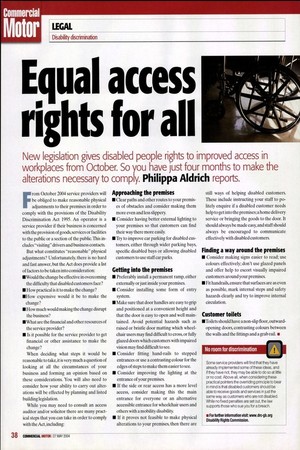Equal access rights for all
Page 40

If you've noticed an error in this article please click here to report it so we can fix it.
New legislation gives disabled people rights to improved access in workplaces from October. So you have just four months to make the
alterations necessary to comply. Philippa Aldrich reports. From October 2004 service providers will be obliged to make reasonable physical adjustments to their premises in order to comply with the provisions of the Disability Discrimination Act 1995. An operator is a
service provider if their business is concerned with the provision of goods, services or facilities to the public or a section of the public. This includes "visiting" drivers and business contacts. But what constitutes "reasonable" physical adjustments? Unfortunately, there is no hard and fast answer, but the Act does provide a list of factors to be taken into consideration:
• Would the change be effective in overcoming the difficulty that disabled customers face?
• How practical is it to make the change?
• How expensive would it be to make the change?
• How much would making the change disrupt the business?
• What are the financial and other resources of the service provider?
• Is it possible for the service provider to get financial or other assistance to make the change? When deciding what steps it would be reasonable to take, it is very much a question of looking at all the circumstances of your business and forming an opinion based on these considerations. You will also need to
consider how your ability to carry out alterations will be effected by planning and listed building legislation. While you may need to consult an access auditor and/or solicitor there are many practical steps that you can take in order to comply with the Act, including: Approaching the premises
• Clear paths and other routes to your premises of obstacles and consider making them more even and less slippery.
• Consider having better external lighting to your premises so that customers can find their way there more easily.
• Try to improve car parking for disabled customers, either through wider parking bays, specific disabled bays or allowing disabled customers to use staff car parks. Getting into the premises
• Preferably install a permanent ramp, either externally or just inside your premises.
• Consider installing some form of entry system.
• Make sure that door handles are easy to grip and positioned at a convenient height and that the door is easy to open and well maintained. Avoid potential hazards such as raised or bristle door matting which wheelchair users may find difficult to cross, or fully glazed doors which customers with impaired vision may find difficult to see.
• Consider fitting hand-rails to stepped entrances or use a contrasting colour for the edges of steps to make them easier to see.
• Consider improving the lighting at the entrance of your premises.
• If the side or rear access has a more level access, consider making this the main entrance for everyone or an alternative accessible entrance for wheelchair users and others with a mobility disability. • If it proves not feasible to make physical alterations to your premises, then there are
still ways of helping disabled customers. These include instructing your staff to politely enquire if a disabled customer needs help to get into the premises; a home delivery service or bringing the goods to the door. It should always be made easy, and staff should always be encouraged to communicate effectively with disabled customers. Finding a way around the premises
• Consider making signs easier to read; use colours effectively; don't use glazed panels and offer help to escort visually impaired customers around your premises.
• Fit handrails, ensure that surfaces are as even as possible, mark internal steps and safety hazards clearly and try to improve internal circulation. Customer toilets • Toilets should have a non-slip floor, outwardopening doors, contrasting colours between the walls and the fittings and a grab rail. • No room for discrimination
Some service providers will find that they have already implemented some of these ideas, and if they have not, they may be able to do so at little or no cost. Above all, when considering these practical pointers the overriding principle to bear in mind is that disabled customers should be able to receive goods and services in just the same way as customers who are not disabled. While no fixed penalties are set out, the law supports those who sue you for a breach.
• For further information visit: www.drc-gb.org Disability Rights Commission.






























































































































































































